1. 引言
IPCC第五次评估报告指出,自19世纪末以来,地球表面平均温度(Global Mean Surface Temperature)一直在升高,过去的30年中,每个十年的温度比有记录以来的任何一个十年的温度都要高。21世纪的头十年是最暖的十年 [1] 。而这样的变化势必会对全球水循环产生重要影响,进而导致全球极端降水事件发生的概率增加 [2] [3] [4] 。梅雨是东亚地区的特征性天气系统,它是东亚大气环流由春季到夏季过度的产物 [5] 。江淮地区梅雨的开始和结束是每年初夏东亚大气环流发生急剧变化的结果,梅雨量的多少反映了东亚夏季风的强弱及其推进到江淮地区的早晚。因此,在全球变暖的背景下,研究梅雨特征量的时间变化特征及异常梅年梅雨期环流特征对于监测江淮地区的旱涝具有十分重要的意义。
在气候平均态下,东亚夏季风于6月中旬推进至江淮地区、韩国、日本一带,与此同时,我国江淮地区连续出现阴雨天气,由于此时恰好是我国江南梅子成熟的季节,故称“梅雨” [6] ,韩国称之为“Changma”,而在日本,梅雨被称为“Baiu”。这两个国家的气象学者也对梅雨进行了深入的研究 [7] [8] [9] [10] 。台湾的气象学者也对台湾地区的梅雨进行了研究 [11] [12] 。
梅雨出、入梅日的确定一直是气象学者们关注的重要课题。上世纪80年代以来,我国气象界围绕梅雨的入、出梅问题进行了长时间的讨论,梅雨期的划分因地域和侧重点的不同有多重划分方法。徐群 [13] 根据长江中下游五站(上海、南京、芜湖、九江和汉口)日降水资料,并结合当时地面天气要素、副热带高压脊线位置等指标,划分出八十年(1885~1963年)的梅雨期。张德二用这种划分方法划定了18世纪长江下游逐年的雨期。胡娅敏 [14] 等用1954~2005年0.5˚ × 0.5˚的逐日降水格点资料,并定义了一个新的江淮地区的“广义梅雨评定标准”,得出江淮地区梅雨在1965年前后,70年代末~80年代初和90年代初发生了三次显著的气候跃变。梁萍 [15] 等从区域角度出发,在明确区域梅雨概念的基础上,选取了江淮区域梅汛期降水变率一致的36个代表站点。采用连续5个滑动候满足侯内雨日≥4的站点覆盖率指标,并结合西太平洋副高脊线位置,提出江淮区域梅雨入、出梅的确定方法。
章淹 [16] 将1885~1995年的梅雨期以1950年为分界点,分成1885~1950年以及1951~1995年两个时期的梅雨,对比发现,上世纪50年代后,梅雨期长度,较之其前期出现了长梅年减少,短梅年增多,集中期缩短,降水总量偏少年增多,降水总量偏多的年份减少。徐群在划分了1885~1964年长江中下游梅雨期基础 [13] 上,进一步划分出了1951年以来江淮下游南北两区的梅雨期 [17] 。通过这两项研究,从而划分出了近116年(1885~2000年)长江中下游沿江五站(上海、南京、芜湖、九江和汉口)梅雨期。魏凤英等 [18] 使用徐群定义的1885~2000年长江中下游梅雨强度 [17] [19] 对116年的梅雨序列进行分析,得出从大的年代际尺度而言,上世纪40年代梅雨强度发生了突变,梅雨由强趋势向较弱趋势转变。毛文书 [20] 等将江淮地区分为南、北两个区,发现南、北两区梅雨量都存在显著不同的多时间尺度振荡周期。
综上所述,关于梅雨的相关研究,我国学者已经取得了许多杰出的研究成果,但以往的研究由于地理位置的差异、侧重点不同,所以各地选取的入、出梅指标也有所差异,梅雨既是天气现象也是气候现象,从天气学角度出发,梅雨是与副热带高压、阻塞高压等相连,是一种大尺度天气现象,从气候学角度出发则要求若干日稳定通过一个数值,降水是一项非常重要的指标,如果过多考虑各地降水要素,则梅雨是一种大尺度天气现象。
针对这一问题,统一的入、出梅指标是非常有必要的。因此,本文采用中国气象局预报与网络司2014年印发的《梅雨监测业务规定》 [21] 中涉及气候区的划分以及新的入、出梅标准,研究梅雨监测区入、出梅日期、梅雨期长度、梅雨强度以及梅雨量等梅雨特征量的年际、年代际变化;讨论各梅雨特征量间的相关性;并在此基础上探究异常梅年的环流场特征。
2. 资料的选取
1) 中国气象局提供的全国824站逐日降水资料,筛选出梅雨监测区92个站点(如图1所示),并从中选出85个降水资料完整、长度超过50年(1961~2010年)的站点。
2) 1961~2010年NCEP/NCAR (National Centers for Environmental Prediction/National Center for Atmospheric Research)提供的逐日再分析资料,该资料包括位势高度场、水平风场、温度场、相对湿度场、比湿度场和垂直速度场等,水平分辨率为2.5˚ × 2.5˚,本文仅使用了高度场和水平风场u,用于计算西太平洋副高脊线条件。
3) 中国气象局预报与网络司2014年印发的《梅雨监测业务规定》涉及的梅雨监测区梅雨期出、入梅日期的确定。
4) 梅雨强度(I)的定义参照文献 [5] ,
 (1)
(1)
式中:L为当年梅雨期长度(天数); 为1961~2010年的平均梅雨期长度;
为1961~2010年的平均梅雨期长度; 为某一年梅雨监测区85站梅雨总量的平均值,
为某一年梅雨监测区85站梅雨总量的平均值, 为梅雨监测区85站1961~2010年梅雨总量的平均值。
为梅雨监测区85站1961~2010年梅雨总量的平均值。
5) 西太平洋副高脊线的定义。由于西太平洋副高脊线的位势高度 在经向上取得最大值,利用地转关系,纬向风u满足:
在经向上取得最大值,利用地转关系,纬向风u满足:
 (2)
(2)
 (3)
(3)
因此,西太副高脊线还可以定义成为沿副热带的热带东风带和中纬度西风带的分界线,即沿该线纬向风速为零 [22] 。本文所用的逐日西太平洋副高脊线就是根据这一定义,利用美国NCEP/NCAR再分析资料求得。
从西太副高脊线的定义可以看出,西太副高脊线是位势高度的极值点,不仅仅局限在588 dagpm内,在586 dagpm内也可能存在。
3. 梅雨监测区梅雨期的划分
3.1. 梅雨期划分标准 [21]
确定区域入、出梅与梅雨期的主要依据是区域内各监测站的降水条件,西北太平洋副高脊线条件、南海夏季风爆发时间等为辅助条件,具体方法如下:
(1) 入、出梅降水条件:
① 雨日的确定:某日区域中有1/3以上监测站出现 ≥ 0.1毫米的降水,且区域内日平均降水量≥2毫米,该日为一个雨日。
② 雨期开端日的确定:从第1个雨日算起,往后2日、3日、……、10日中雨日数占相应时段内总日数的比例 ≥ 50%,则第一个雨日为雨期开端日。
③ 雨期结束日的确定:从雨期的最后1个雨日算起,往前2日、3日、……、10日的雨日数占相应时段内总日数的比例 ≥ 50%,则最后一个雨日为雨期结束日。
④ 雨期的确定:一个雨期需满足以下条件:任何连续10日的雨日比例 ≥ 40%、雨日数 ≥ 6天且没有连续5天(含5天)以上的非雨日、站平均降水强度 ≥ 5毫米/天。一个雨期长度为该雨期的开端日到结束日所经历的日数。
⑤ 入梅时间确定:第一个雨期的开端日即为入梅日。
⑥ 出梅时间确定:最后一个雨期结束日的次日即为出梅日。
⑦ 梅雨期的确定:梅雨期内可以出现有一个以上的雨期,梅雨期长度为入梅日到出梅日前一天的日数。
(2) 梅雨期的其它条件
① 梅雨发生在南海夏季风爆发之后(气候值为5月第5候),7月中旬之后不再有新的雨期开端日。
② 西北太平洋副热带高压脊线条件:梅雨期内,逐日西北太平洋副热带高压脊线位置一般要求满足条件:18˚N~27˚N。
3.2. 梅雨期的划分结果
根据以上的资料以及梅雨划分标准,计算出了1961~2010年梅雨监测区入梅日、出梅日、梅雨期长度、梅雨量和梅雨强度等梅雨特征量(表1)。

Table 1. Main features of Monitoring area of Meiyu during 1961-2010
表1. 梅雨监测区1961~2010年各梅雨特征量的统计
续表
注:斜体加粗的年份为二度梅年。
从表1中可以看出,1961~2010年间,梅雨监测区一共出现了5次二度梅现象(1977、1982、1984、1991和2000)。没有空梅年(当年没有达到入梅条件)。不计二度梅年(一年中有两个梅雨期),最早入、出梅时间分别为:5月26日(1971年)、6月11日(1961年);最晚入、出梅时间分别为:7月13日(1974年)、8月2日(1987年);最小梅雨量为64.027 mm (2005年),最大梅雨量为531.659 mm (1983年)。
图2为梅雨监测区1961~2010年各梅雨特征量的时间序列(二度梅年的入、出梅日为两个梅雨期的平均值),从图中可以看出,各梅雨特征量年际变化显著,上世纪70年代初和本世纪初,入梅日有偏晚的趋势,70年代中期至90年代末,入梅日有偏早的趋势,总体来看入梅日变化不显著。出梅日存在两个偏晚的时期(上世纪60年代、本世纪初),一个偏早的时期(上世纪90年代末),一个较为稳定的时期(上世纪70年代~90年代中后期)。总的来说,出梅日较为稳定。
梅雨期长度和梅雨强度的变化情况较为一致,上世纪60年代梅雨期变长,梅雨强度增强,70年代初、90年代末梅雨期变短,梅雨强度减弱,70年代中期~90年代中期梅雨期长度和梅雨强度呈波动式变化。总体而言,梅雨期稍有变长,梅雨强度稍有加强,不过不是很显著。
M-K突变检验显示(图3),梅雨监测区入、出梅日、梅雨期长度以及梅雨强度均没有发生突变。
为了深入了解各梅雨特征量间的相关程度,计算了各梅雨特征量间的相关系数,结果如下:梅雨强度与梅雨量和梅雨期长度高度相关,相关系数均超过0.9。入梅日与出梅日间的相关系数为0.545,通过了α = 0.001的显著性检验,说明入梅时间越晚,出梅时间越晚,反之亦然。出梅日和梅雨期长度、梅雨量以及梅雨强度的相关系数分别为:0.615、0.491、0.536,均通过α = 0.001的显著性检验。入梅日梅雨期长度、梅雨量以及梅雨强度的相关系数分别为:−0.326、−0.302、−0.325,也通过了α = 0.05的显著性水平检验。说明出梅日和梅雨期长度、梅雨量以及梅雨强度的相关性比入梅日与它们的相关性要高。

 (a) (b)
(a) (b)
 (c) (d)
(c) (d)
Figure 2. Time series for onsets (a), withdrawals (b), length (c) and intensity (d) of Meiyuduring 1961-2010 (Note: the solid line is the actual value, the short line is 5 years moving average, dotted line is the linear trend)
图2. 1961~2010年梅雨监测区入梅日期(a)、出梅日期(b)、梅雨期长度/天(c)和梅雨强度(d)时间序列(注:实线为实际值,短划线为5年滑动平均,点线为线性趋势)
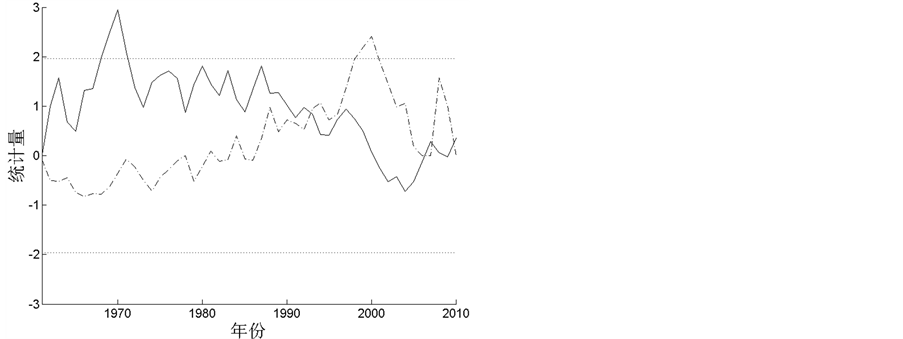
 (a) (b)
(a) (b)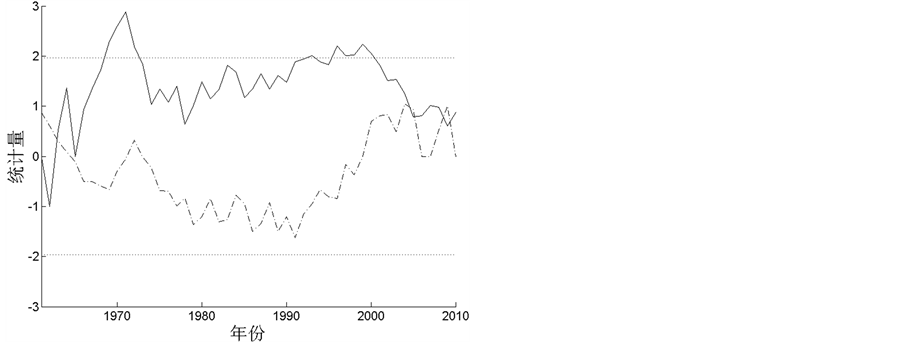
 (c) (d)
(c) (d)
Figure 3. M-K test for onsets (a), withdrawals (b), length (c) and intensity (d) of Meiyu during 1961-2010 (Note: the solid line is UF statistic, the short line is UB statistic, dotted line is the confidence level test line)
图3. 1961~2010年梅雨监测区入梅日期(a)、出梅日期(b)、梅雨期长度(c)和梅雨强度(d)的M-K检验。(注:实线为UF统计量,虚线为UB统计量,点线为α = 0.05置信水平检验线)

Table 2. Main features of Meiyu per decade during 1961-2010
表2. 1961~2010年梅雨监测区各年代际梅雨特征量的统计
表2为1960~2010年梅雨监测区各年代际梅雨特征量,梅雨监测区50年平均入梅日期为6月16日,平均出梅日期为7月9日。除了上世纪90年代偏早较多外,各年代平均入、出梅日波动较小,体现出较强的稳定性。其余各梅雨特征量体现了较为一致的年代际变化趋势。上世纪80年代、90年代,梅雨期偏长,梅雨量偏多,梅雨强度偏强,上世纪60年代、70年代、本世纪以来表现为梅雨量偏少,梅雨强度偏弱。
4. 异常梅年环流特征
西太平洋副高脊线(以下简称西太副高脊线)对我国东部地区夏季降水有着显著的影响,其具有规律性的北跳与我国东部地区的雨季起止时间以及雨带的位置关系密切 [23] [24] 。一般而言,脊线偏南(北),华南降水偏多(少)、华北上空可降水量偏少(多) [25] [26] 。
因此,本章选用梅雨监测区来探讨异常梅年(早梅年、晚梅年、二度梅年)环流场特征。
关于早、晚梅的确定,本文参照文献 [5] ,即在6月中旬初(6月12日)及以前入梅的,称为早入梅,在6月23日或以后入梅的,称晚入梅。在7月上旬前期(7月2日)出梅的划为出梅偏早,在7月下旬(7月22日)出梅的划为出梅偏晚。结合第四章关于各区入、出梅日的划分结果,得出了梅雨监测区1961~2010年间的早入梅、晚入梅、早出梅及晚出梅四种异常梅类型。
4.1. 早、晚梅年与西太副高脊线的关系
表3为梅雨监测区早、晚梅情况,结合表1可得,早、晚入梅年平均入梅日分别为6月5日、7月1日。早、晚出梅年平均出梅日分别为:6月23日、7月25日。因此,本文选定早、晚梅年的平均入、出梅日前一候及后一候进行合成分析来探讨早、晚梅年西太副高脊线的情况。
从图4中,可以得出:在平均早入梅日前后,早入梅年,西太平洋副高面积较大,呈条带状分布,西太副高脊线达到20˚N,588 dagpm等高线西伸至130˚E以西,靠近我国台湾地区,符合入梅的西太副高脊线条件;晚入梅年,西太平洋副高面积明显减小,位置明显偏东,588 dagpm等高线最西没有达到140˚E,并未符合入梅的西太副高脊线条件。
从图5中,可以得出:在平均晚出梅日前后,早出梅年,西太平洋副高位置偏北,588 dagpm等高线经过日本,西太副高脊线超过30˚N;晚出梅年,西太平洋副高依旧强大,588 dagpm等高线经过我国台湾、浙江、福建等地。590 dagpm等高线接近我国华东地区,西段副高脊线在30˚N附近,刚好达到出梅的西太副高脊线条件。
4.2. 五个二度梅年的环流特征
典型梅雨期500 hPa的环流形势为:西太平洋副热带高压呈带状分布,西太副高脊线略成东北西南走向,在120˚E处稳定在22˚N左右;孟加拉湾或印度东部一带有稳定的低压槽存在,给长江中下游地区输送水气;中纬度地区西风带环流比较平直;高纬地区有阻塞高压形势 [27] [28] 。
4.2.1. 1977年梅雨期环流特征
从图6中可以看出:第一个梅期(a),西太平洋副高较强,588 dagpm等高线西伸达到130˚E,西太副高脊线均超过20˚N,乌拉尔山脉附近和雅库茨克附近各有一个高压脊。35˚~40˚N之间等高线较为平直;两个梅期之间(b),588 dagpm等高线在130˚~160˚E之间被切断,形成东西两个副高,其中,较西的副高

Table 3. Early and late Meiyu situation
表3. 梅雨监测区早、晚梅情况
 (a)
(a)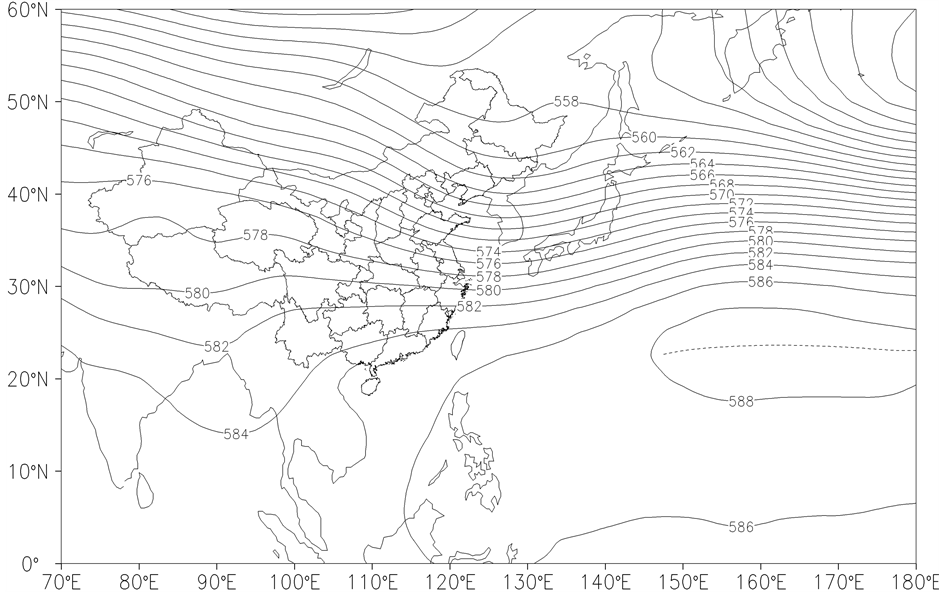 (b)
(b)
Figure 4. Composite graph of Early and late onsets of Meiyu from June 1st to June 10th
图4. 梅雨监测区早(a)、晚(b)入梅年6月1日~10日合成图
 (a)
(a) (b)
(b)
Figure 5. Composite graph of Early and late withdrawals of Meiyu from July 21st to July 30th
图5. 梅雨监测区早(a)、晚(b)出梅年7月21日~30日合成图
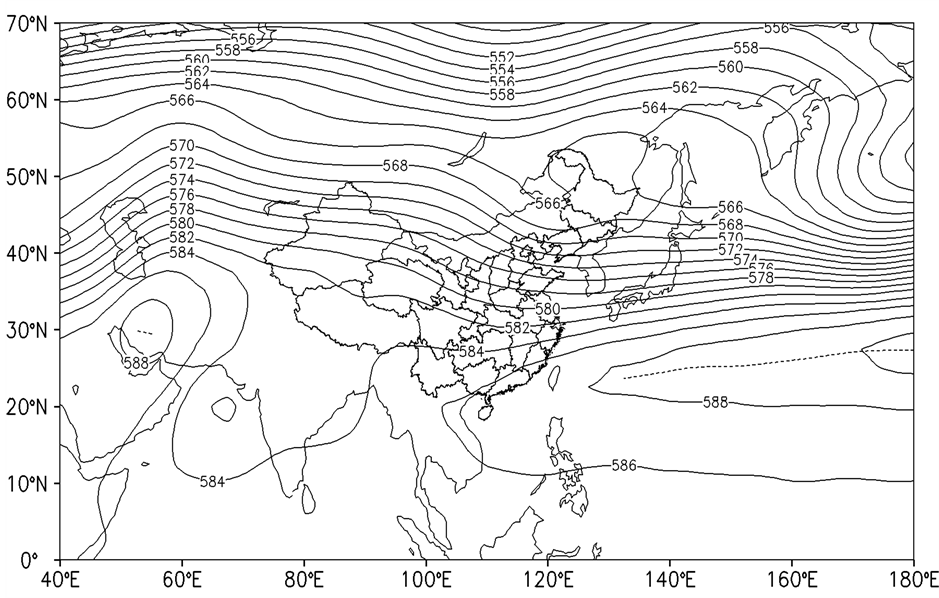 (a)
(a) 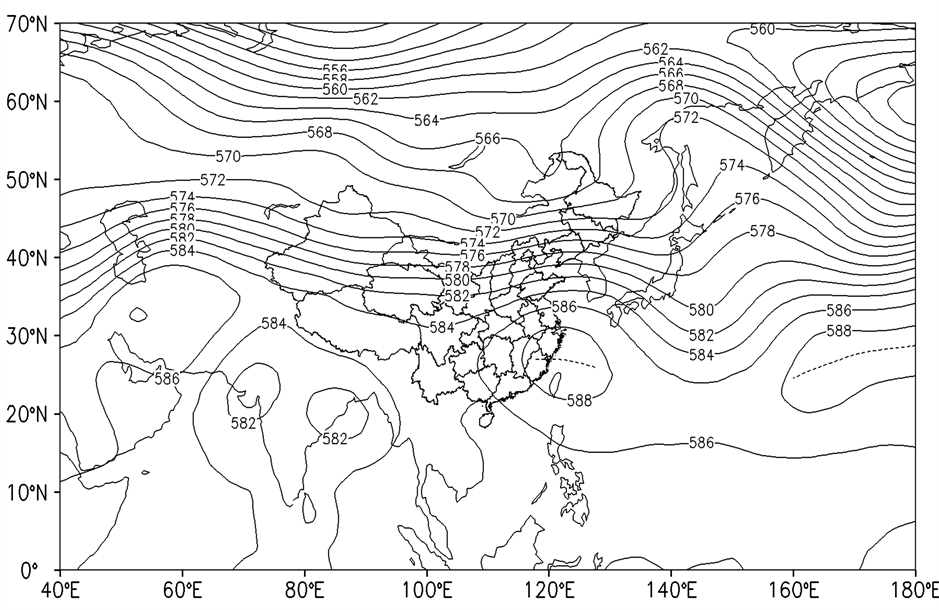 (b)
(b) 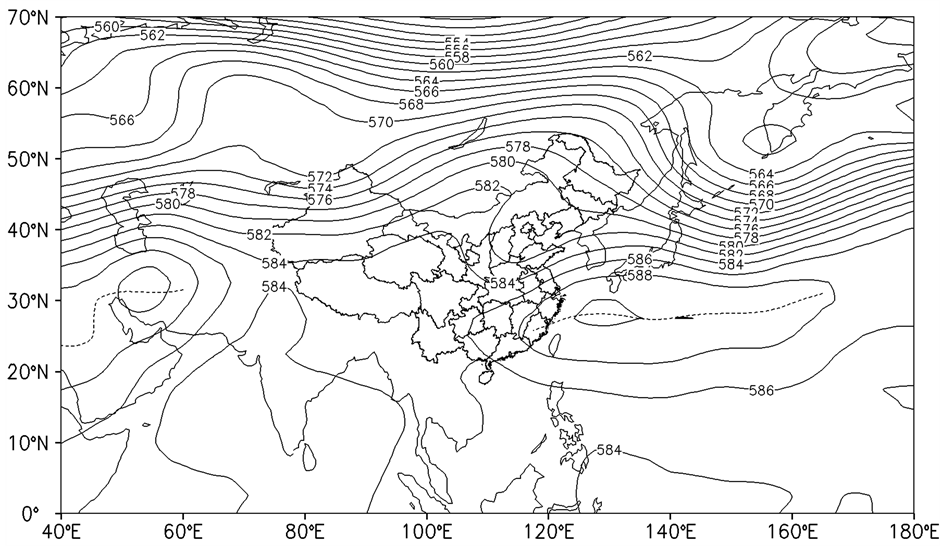 (c)
(c) (d)
(d)
Figure 6. Composite graph of first Meiyu period (a), interval between two Meiyu period (b), second Meiyu period (c), ten days after withdrawal (d) of 1977
图6. 梅雨监测区1977年第一个梅期(a)、两个梅期间(b)、第二个梅期(c)和出梅后10天(d)合成图
588 dagpm等高线位于我国浙江、福建以及江西等地上空,与此同时,梅雨监测区日均温连续6天超过30度,9天中仅有1个雨日;第二个梅期(c),相比较于第一个梅期,副高位置更偏西,西太副高脊线位置更偏北,590 dagpm等高线西伸至130˚E,第二个梅期的平均温度(26.98℃)高于第一个梅期的(24.12℃)。第二个梅期后(d),环流场调整,西太平洋副高又被切断为东西两个,东侧的西太副高脊线北跳至40˚N附近,西侧的西太平洋副高进一步西伸,588 dagpm等高线几乎全部在我国长江中下游上空,此期间梅雨监测区再次出现日均温高于30˚的连续高温天气。
4.2.2. 1982年梅雨期环流特征
从图7中可以看出:第一个梅期(a),西太平洋副高成东西条带状分布,位置偏西,588dagpm等高线经过我国海南岛,西太副高脊线稳定超过20°N,孟加拉湾有一个低槽;两个梅期之间(b),环流场调整,副高东退至140°E以东,梅雨监测区出现连续7天的非雨日,但并未出现高温天气。第二个梅期(c),副高再次西进,588dagpm等高线最西端在我国广东省上空,脊线位置相对于第一个梅期整体北移;第二个梅期后(d),受双台风(编号8210和8211)影响,副高被迫北移,梅雨监测区没有出现连续的高温天气。
4.2.3. 1984年梅雨期环流特征
从图8中可以看出:第一个梅期(a),在50˚~70˚N范围内,贝加尔湖以北有一个阻高,乌拉尔山脉附近和鄂霍次克海附近存在一个高压脊。孟加拉湾附近和我国东北地区有一个低槽,副高较往常弱,面积偏小。两个梅期之间(b),位于鄂霍次克海和乌拉尔山脉附近的高压脊消失,副高东退明显,588 dagpm等高线在150˚E以东,梅雨监测区没有出现连续的高温天气;第二个梅期(c),位于贝加尔湖西侧有一个高压脊,乌拉尔山脉附近阻高恢复,副高西进加强,588 dagpm等高线最西接近120˚E,35˚~40˚N是一支比较平直的西风;第二个梅期后(d),40˚~60˚E间588 dagpm北移至里海,西太平洋副高强度减弱,梅雨监测区出现连续10天的非雨日。
4.2.4. 1991年梅雨期环流特征
从图9中可以看出:第一个梅期(a),孟加拉湾附近存在一个低槽,副高成条带状分布,西太副高脊线西进至120˚E附近;两个梅期之间(b),孟加拉湾附近的低槽减弱,35˚~40˚N之间的等高线波动较大,
 (a)
(a)  (b)
(b)  (c)
(c)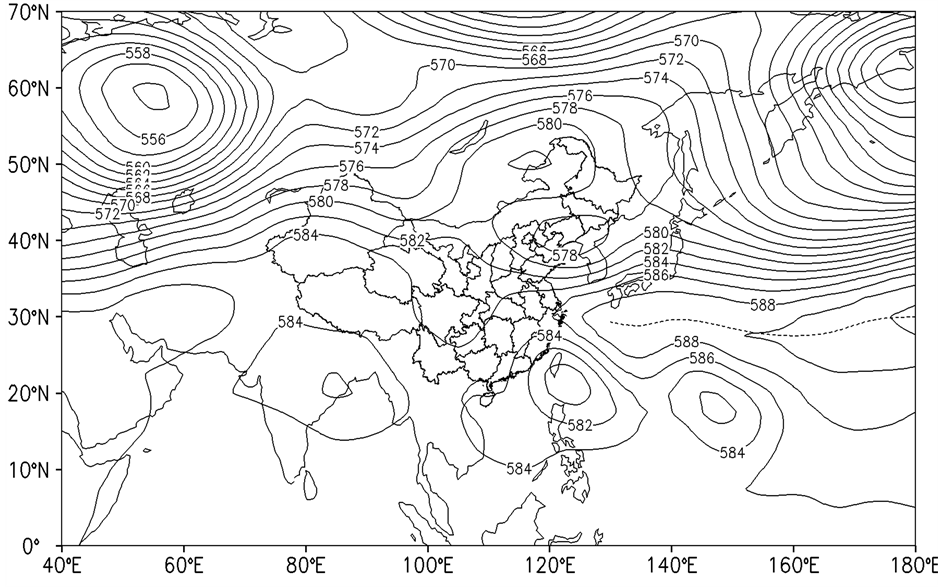 (d)
(d)
Figure 7. Composite graph of first Meiyu period (a), interval between two Meiyu period (b), second Meiyu period (c), four days after withdrawal (d) of 1982
图7. 梅雨监测区1982年第一个梅期(a)、两个梅期间(b)、第二个梅期(c)和出梅后4天(d)合成图
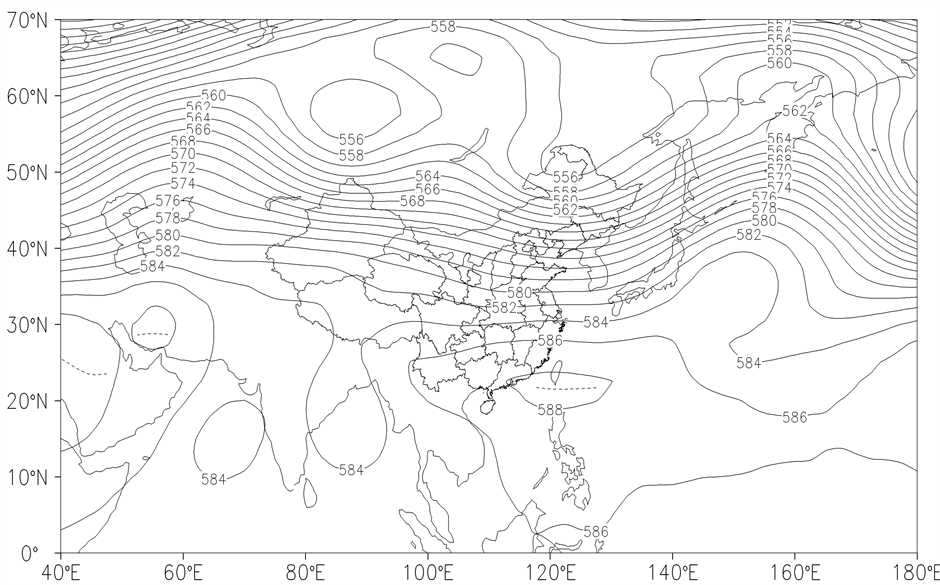 (a)
(a) 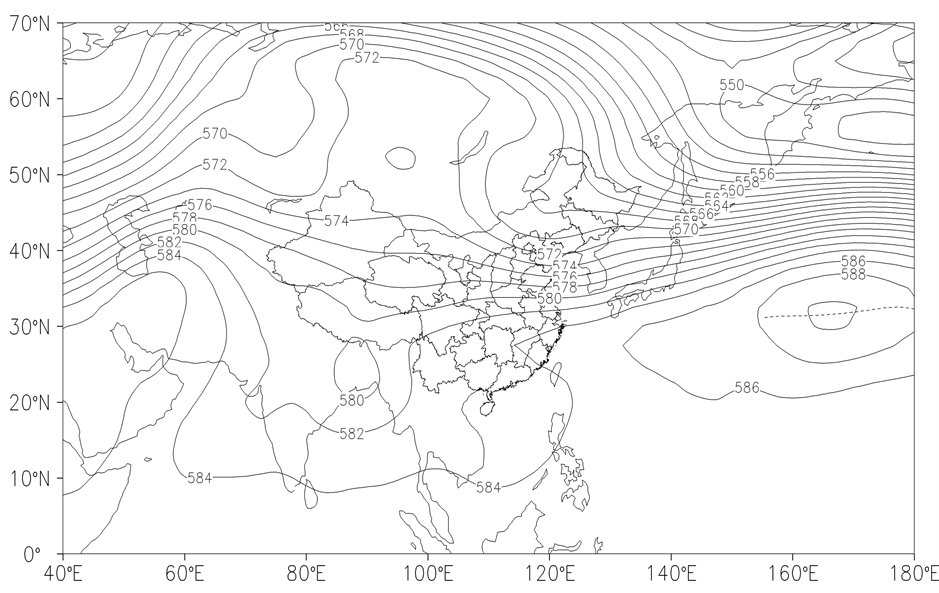 (b)
(b) 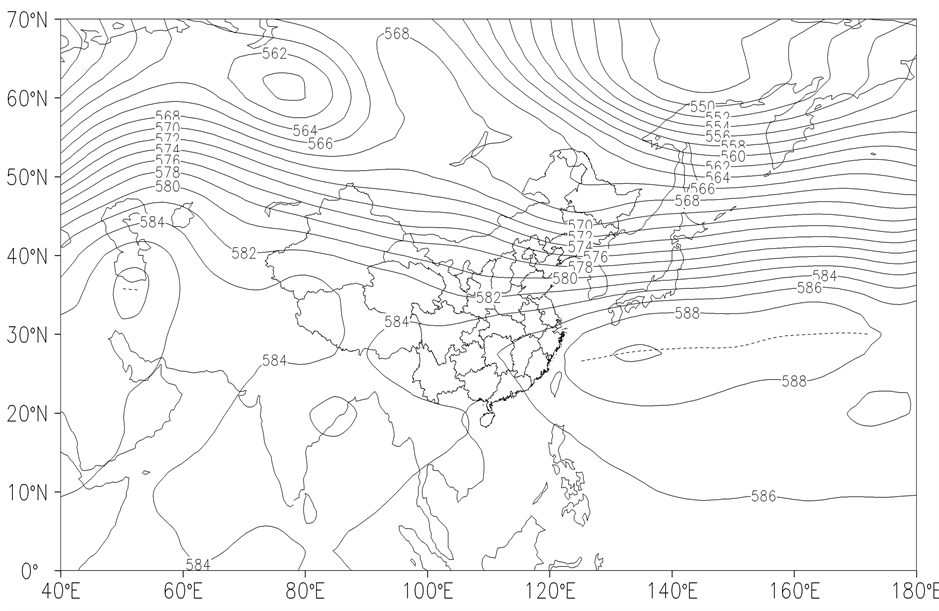 (c)
(c)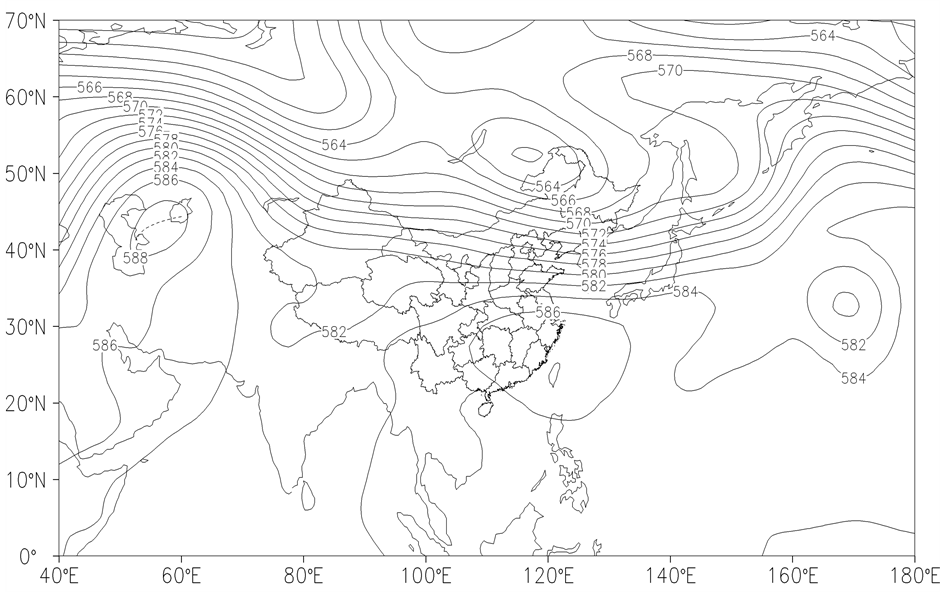 (d)
(d)
Figure 8. Composite graph of first Meiyu period (a), interval between two Meiyu period (b), second Meiyu period (c), eleven days after withdrawal (d) of 1984
图8. 梅雨监测区1984年第一个梅期(a)、两个梅期间(b)、第二个梅期(c)和出梅后11天(d)合成图
 (a)
(a) 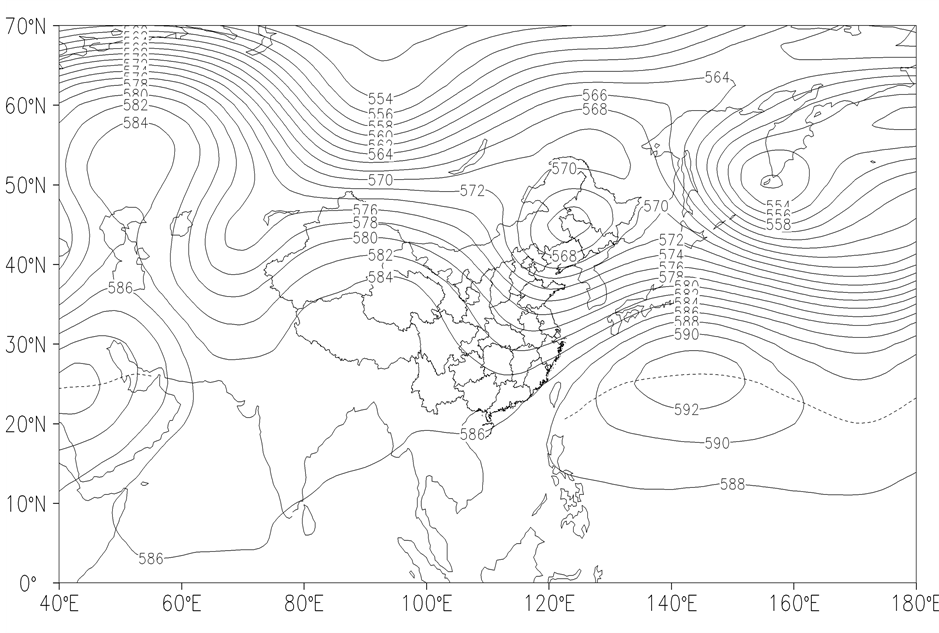 (b)
(b) 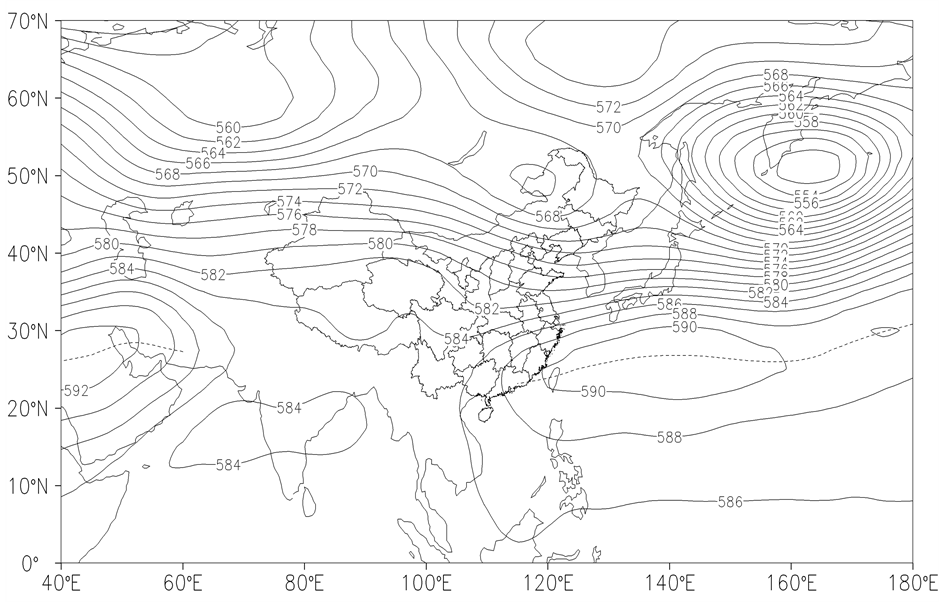 (c)
(c) (d)
(d)
Figure 9. Composite graph of first Meiyu period (a), interval between two Meiyu period (b), second Meiyu period (c), thirteen days after withdrawal (d) of 1991
图9. 梅雨监测区1991年第一个梅期(a)、两个梅期间(b)、第二个梅期(c)和出梅后13天(d)合成图
梅雨监测区连续9天没有雨日;第二个梅期(c),35˚~40˚N之间的等高线较为平直,副高恢复为条带状分布;第二个梅期后(d),西太副高脊线北跳至30˚N附近,副高继续西进,588 dagpm在我国浙江、安徽南部、江苏南部等地上空,梅雨监测区出现了连续13天日均温高于30℃的高温天气。
4.2.5. 2000年梅雨期环流特征
从图10中可以看出:第一个梅期(a),副高比常年同期(5月底)要强,且位置偏北,脊线最西已在广东境内,贝加尔湖上空有一个高压脊,西侧有一个低压,东侧有一个低槽。孟加拉湾也有一个低槽,35˚~40˚N间西风环流较平直;两个梅期之间(b),环流场调整,中高纬度等高线较为平直,无明显的阻高,孟加拉湾低槽消失,副高东退,588 dagpm消失;第二个梅期(c),在50˚~70˚N之间乌拉尔山脉附近存在一个高压脊,副高再次北跳;相比较第一个梅期,西太副高脊线位置偏北,第二个梅期后(d),副高强度减弱,东退至140˚E以东,梅雨监测区没有出现大范围连续高温天气。
5. 结论
本文在选定《梅雨监测业务规定》的基础上,采用美国NECP/NCAR的再分析资料和1961~2010年逐日的降水资料,讨论了50年梅雨监测区各梅雨特征量的年际和年代际变化。并在此基础上探究异常梅年的环流场特征。得到如下结论:
1) 各梅雨量间具有高度的相关性,绝大多数通过置信水平α = 0.001的显著性检验。梅雨量越多的年
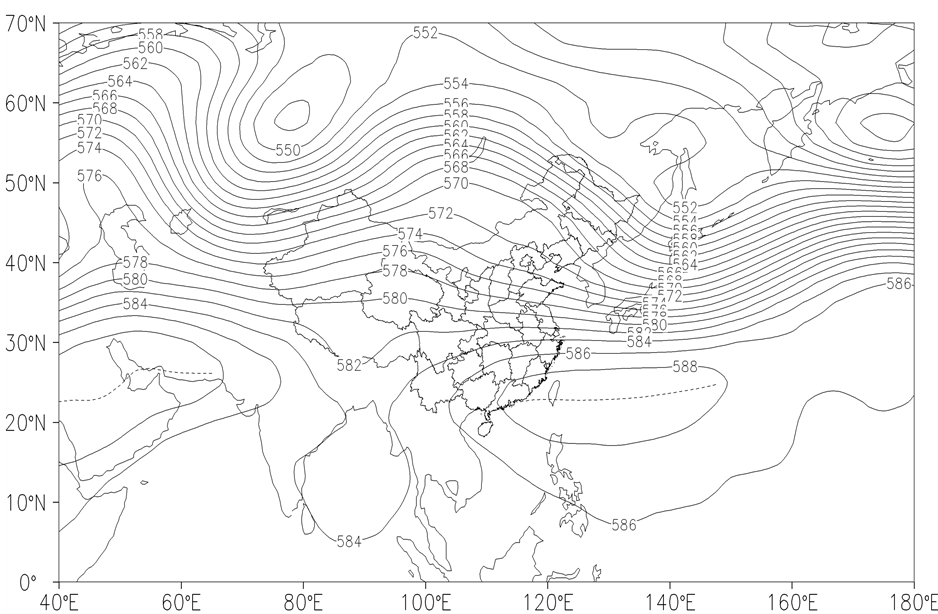 (a)
(a)  (b)
(b) 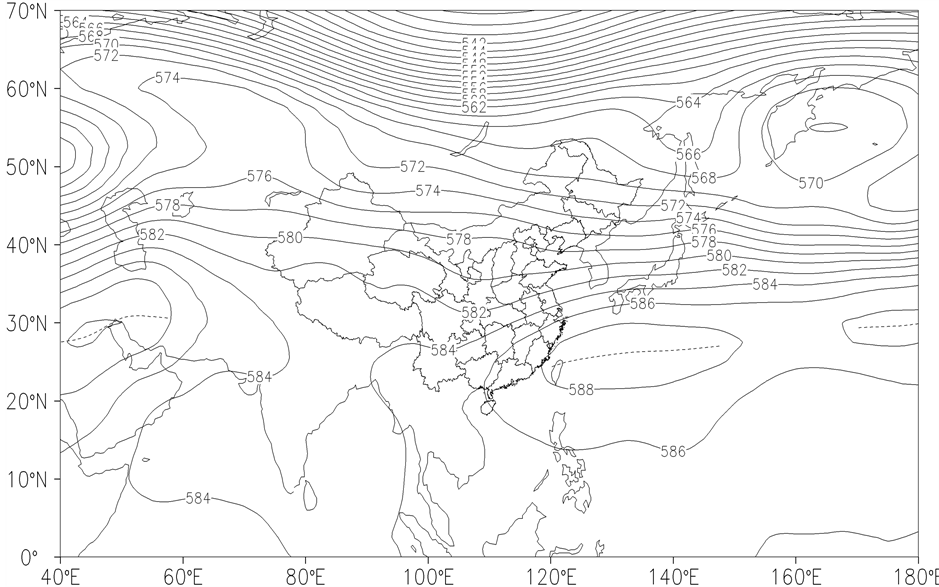 (c)
(c) (d)
(d)
Figure 10. Composite graph of first Meiyu period (a), interval between two Meiyu period (b), second Meiyu period (c), seven days after withdrawal (d) of 2000
图10. 梅雨监测区2000年第一个梅期(a)、两个梅期间(b)、第二个梅期(c)和出梅后7天(d)合成图
份,其梅雨期长度、雨日数越长、梅雨量距平百分率越高;入梅时间和出梅时间成正相关关系;入梅时间越早、出梅时间越晚,梅雨强度越大;出梅日和梅雨量、梅雨期长度、梅雨期雨日数、距平百分率以及梅雨强度的相关性比入梅日和它们的相关性要好。
2) M-K突变检验显示,梅雨监测区入、出梅日、梅雨期长度以及梅雨强度均没有发生突变。
3) 在平均早入梅日前后,早入梅年,西太平洋副高较为强大,位置偏西北,副高脊线超过20˚N;晚入梅年,西太平洋副高面积明显减小,位置明显偏东。在平均晚出梅日前后,早出梅年,西太平洋副高位置偏北,西太副高脊线超过30˚N;晚出梅年,西太平洋副高依旧强大,西段副高脊线在30˚N附近。
4) 5个二度梅年梅雨期的环流形势与典型梅雨期类似,在50˚~70˚N间有一个稳定的高压脊,在35˚~40˚N间存在一支比较直的西风,孟加拉湾附近有一个低槽,西太平洋副高较强(除1984年第一个梅雨期副高较弱),位置偏西,呈条带状分布,西太副高脊线位置在110˚~130˚E普遍超过20˚N。
基金项目
973国家重大科学研究计划(2012CB955803)资助;国家自然科学基金人才培养项目(J1310028);华东师范大学大型仪器设备开放基金资助。